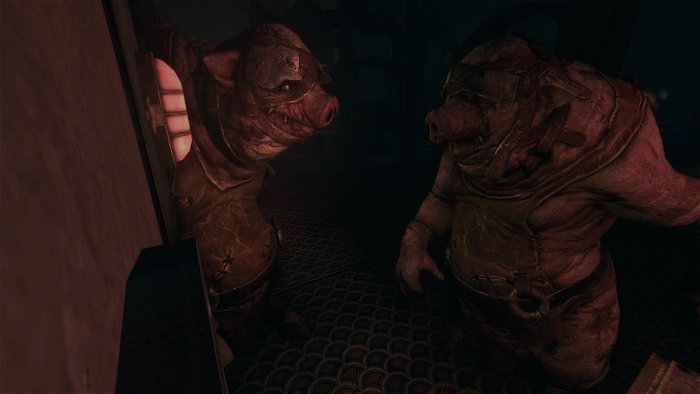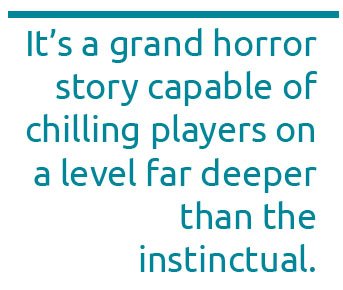I love October. I love the weather, the colours on the trees, and, most of all, Hallowe’en. To celebrate this most spooky of holidays I’ll be discussing topics related to horror each week of the month in a series of articles called . . . OCTERROR!
This article discusses key plot points from Amnesia: A Machine for Pigs. Please don’t read on if you’d prefer to avoid spoilers.
I have a theory that Amnesia: A Machine for Pigs received a fairly tepid response from players only because it’s a sequel to a horror game that, while sharing a handful of superficial similarities, it has very little in common with. The Chinese Room’s follow-up to Frictional Games’ 2010 Amnesia: The Dark Descent is, again, a game that casts players in the role of a man who awakens in a strange, ominous environment without any memory of his situation. It also features a story that reveals itself through bits and pieces of reclaimed memories and a character who is powerless to fight off the strange creatures he encounters. But A Machine for Pigs has a very different purpose than The Dark Descent. It, as many players noted after first experiencing it, is not so much concerned with being absolutely terrifying as it is with using the horror genre to make a statement about humanity.

The Chinese Room is best known for Dear Esther, a title that has polarized audiences by largely forgoing traditional gameplay mechanics in favour of atmospheric storytelling. Many of the complaints levelled at A Machine for Pigs centred around the fact that its developer took a relatively similar approach with their Amnesia sequel, doing away with puzzles, inventory system, and sanity-managing mechanics to concentrate instead on little else than creating an interactive narrative for players to explore. It’s a decision that understandably disappointed those hoping for more of the intense fear and puzzle-filled gameplay that Frictional Games offered with The Dark Descent. But, what is often lost in these kind of complaints is a discussion of just how effectively The Chinese Room’s version of Amnesia tells its story.

A Machine for Pigs’ plot focuses on wealthy industrialist (and player character) Oswald Mandus as he searches for his lost children by delving ever deeper into the enormous, seemingly living machine he created. As the player guides Mandus deeper and deeper into the grimy bowels of the enormous industrial plant, it is slowly revealed that the machine works as a meat processor that sacrifices workers from the game’s 19
century London setting to turn them into pork-like food for the country’s masses. As macabre as this is on its surface, the horror is given added context by the fact that A Machine for Pigs’ events take place on New Year’s Eve, 1899 and foreshadow one of humanity’s darkest centuries. After a glimpse of the coming decades—and the death of his twin sons during the First World War’s Battle of the Somme—from a strange Mexican artifact, Mandus returns to London bent on creating a machine that will extinguish the human race before it has a chance to enter a new, war-stricken epoch. Mandus, having seen what is to come from his era’s European imperialism and unchecked class disparities, seeks to ward off the inevitable tragedies of World and Cold wars alike by eliminating England with a massive, self-perpetuating sacrificial abattoir.
It’s a grand horror story capable of chilling players on a level far deeper than the instinctual. The climax of Mandus’ journey into the heart of his machine speaks of the many horrors awaiting the 20
century, the narrator describing the innocent women and men who will be slaughtered at Cambodia, Hiroshima, Nagasaki, the Siberian gulags, and the Somme. These are real events from our collective history—ones that our species is still grappling with the ramifications of today. By linking atrocity with the rise of industrialism, imperialism, and capitalism, The Chinese Room asks players to put the fantastical terror of the game into the context of our everyday lives. A Machine for Pigs wants to give its audience more than just a series of disposable thrills: it wants us to consider the past and identify how it continues to echo into the present day.
Horror is a great genre for creators to work within when exploring real-world issues. Monsters, ghosts, and bizarre, blood-curdling occurrences might seem like storytelling tools only suitable for scaring the wits out of people, but they’re all actually great grounds for metaphor. Once players have been drawn into games with the promise of being entertained by spooky thrills, it’s possible to use these same plot elements to tell stories that speak to the kind of social, political, and cultural realities audiences may have otherwise dismissed as dull, dry topics. That is exactly what The Chinese Room does with A Machine for Pigs and it’s one of the biggest reasons I think it’s a criminally maligned horror title. The game may not have the overt scares of the original Amnesia, but it does offer an exceptional story that is both extremely well told and haunting long after it has come to a conclusion.
Want more horror? Pick up the Horror issue of CGM online and in stores.




